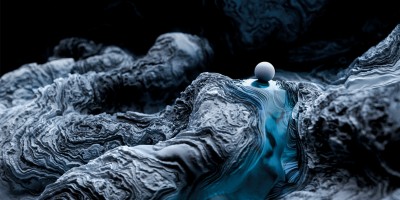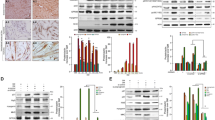Abstract
Skeletal muscle is composed of multinucleated fibres, formed after the differentiation and fusion of myoblast precursors1. Skeletal muscle atrophy and hypertrophy refer to changes in the diameter of these pre-existing muscle fibres. The prevention of atrophy would provide an obvious clinical benefit; insulin-like growth factor 1 (IGF-1) is a promising anti-atrophy agent2,3,4,5 because of its ability to promote hypertrophy. However, the signalling pathways by which IGF-1 promotes hypertrophy remain unclear, with roles suggested for both the calcineurin/NFAT (nuclear factor of activated T cells) pathway6,7 and the PtdIns-3-OH kinase (PI(3)K)/Akt pathway8. Here we employ a battery of approaches to examine these pathways during the hypertrophic response of cultured myotubes to IGF-1. We report that Akt promotes hypertrophy by activating downstream signalling pathways previously implicated in activating protein synthesis: the pathways downstream of mammalian target of rapamycin (mTOR) and the pathway activated by phosphorylating and thereby inhibiting glycogen synthase kinase 3 (GSK3). In contrast, in addition to demonstrating that calcineurin does not mediate IGF-1-induced hypertrophy, we show that IGF-1 unexpectedly acts via Akt to antagonize calcineurin signalling during myotube hypertrophy.




Similar content being viewed by others
References
Engel, A. G. & Fanzine-Armstrong, C. Myology 1937 (McGraw-Hill, New York, 1994).
Renganathan, M., Messi, M. L., Schwartz, R. & Delbono, O. FEBS Lett. 417, 13–16 (1997).
Adams, G. R. & Haddad, F. J. Appl. Physiol. 81, 2509–2516 (1996).
Goldspink, G. J. Anat. 194, 323–334 (1999).
Florini, J. R., Ewton, D. Z. & Coolican, S. A. Endocr. Rev. 17, 481–517 (1996).
Musaro, A., McCullagh, K. J., Naya, F. J., Olson, E. N. & Rosenthal, N. Nature 400, 581–585 (1999).
Semsarian, C., Sutrave, P., Richmond, D. R. & Graham, R. M. Biochem. J. 339, 443–451 (1999).
Rommel, C. et al. Science 286, 1738–1741 (1999).
Friday, B. B., Horsley, V. & Pavlath, G. K. J. Cell Biol. 149, 657–666 (2000).
Dudek, H. et al. Science 275, 661–665 (1997).
Svegliati-Baroni, G. et al. Hepatology 29, 1743–1751 (1999).
Yu, H. & Berkel, H. J. LA State Med. Soc. 151, 218–223 (1999).
Olson, E. N. & Williams, R. S. Cell 101, 689–692 (2000).
Wesselborg, S., Fruman, D. A., Sagoo, J. K., Bierer, B. E. & Burakoff, S. J. J. Biol. Chem. 271, 1274–1277 (1996).
Eves, E. M. et al. Mol. Cell. Biol. 18, 2143–2152 (1998).
Aman, M. J., Lamkin, T. D., Okada, H., Kurosaki, T. & Ravichandran, K. S. J. Biol. Chem. 273, 33922–33928 (1998).
Carver, D. J., Aman, M. J. & Ravichandran, K. S. Blood 96, 1449–1456 (2000).
Liu, Q. et al. Genes Dev. 13, 786–791 (1999).
Jacob, A., Cooney, D., Tridandapani, S., Kelley, T. & Coggeshall, K. M. J. Biol. Chem. 274, 13704–13710 (1999).
Bohni, R. et al. Cell 97, 865–875 (1999).
Huang, H. et al. Development 126, 5365–5372 (1999).
Leevers, S. J., Weinkove, D., MacDougall, L. K., Hafen, E. & Waterfield, M. D. EMBO J. 15, 6584–6594 (1996).
Montagne, J. et al. Science 285, 2126–2129 (1999).
Bodine, S. C. et al. Nature Cell Biol. 3, 1014–1019 (2001).
Glass, D. J. et al. Cold Spring Harb. Symp. Quant. Biol. 57, 53–62 (1992).
Azpiazu, I., Saltiel, A. R., DePaoli-Roach, A. A. & Lawrence, J. C. J. Biol. Chem. 271, 5033–5039 (1996).
Acknowledgements
We thank L. S. Schleifer and P. R. Vagelos for enthusiastic support, along with the rest of the Regeneron community; T. Salomon and J. McCormick for expert assistance with the FACS; S. Staton and E. Burrows for graphics work; A. Bellacosa, P. Tsichlis and J. Blenis for providing reagents and advice; J. Wodgett for the dominant negative GSK3β; and E. Hafen for sharing results before publication.
Author information
Authors and Affiliations
Corresponding author
Rights and permissions
About this article
Cite this article
Rommel, C., Bodine, S., Clarke, B. et al. Mediation of IGF-1-induced skeletal myotube hypertrophy by PI(3)K/Akt/mTOR and PI(3)K/Akt/GSK3 pathways. Nat Cell Biol 3, 1009–1013 (2001). https://doi.org/10.1038/ncb1101-1009
Received:
Revised:
Accepted:
Published:
Issue Date:
DOI: https://doi.org/10.1038/ncb1101-1009
- Springer Nature Limited
This article is cited by
-
Elastic porous microspheres/extracellular matrix hydrogel injectable composites releasing dual bio-factors enable tissue regeneration
Nature Communications (2024)
-
Antioxidant effects of LEDT in dystrophic muscle cells: involvement of PGC-1α and UCP-3 pathways
Photochemical & Photobiological Sciences (2024)
-
Protective effect of Luffa cylindrica Roemer against dexamethasone-induced muscle atrophy in primary rat skeletal muscle cells
Journal of Muscle Research and Cell Motility (2024)
-
Insulin signaling in skeletal muscle during inflammation and/or immobilisation
Intensive Care Medicine Experimental (2023)
-
Ginsenosides Rh1, Rg2, and Rg3 ameliorate dexamethasone-induced muscle atrophy in C2C12 myotubes
Food Science and Biotechnology (2023)





